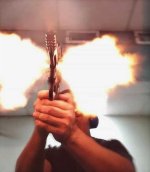It is not a "flaw" in the Combat Magnum/Model 19 revolver, it is an incompatibility between a revolver design dating to 1899 and a cartridge operating at 8,000-12,000 PSI, and the high-intensity variations of .357 Magnum operating at three times the original pressure the gun was designed for!
There is a slightly thin area at the bottom of the barrel shank to clear the yoke and gas ring of the cylinder. At original pressures, even +P .38 Special, and standard bullet weight .357 Magnum pressures the design was adequate. When the lighter 110 and 125 grain bullet loads became popular because of the higher velocity they generated this thin area of the barrel shank often would fail. Not so much as pressure as the dynamics of the load imposing significantly higher strain on the barrel shank. So far as I know there has never been an actual engineering study to determine the specific reason for the failures, but there is more than adequate anecdotal evidence proving that these failures do happen, sometimes. You have to understand that 110 and 125 grain jacketed .357 magnum factory ammunition did not exist when the Model 19 was originally designed, and very little jacketed 158 grain ammunition. As long as lead bullet ammunition was used there were no reports I have ever heard of barrel failure!
I have heard reports of the failure immediately causing functional problems, and have seen revolvers with cracks still functioning normally and the owner was unaware they had a cracked barrel. It does seem these are sudden, catastrophic failures as a result of progressive fatigue.
You have to remember the Combat Magnum/Model 19 was never intended for full-time use with full power .357 Magnum ammunition. The intent was a lighter weight police service revolver ala the Combat Masterpiece/Model 15, to be shot mostly with .38 Special ammunition that the design was originally intended for, but capable of safely firing full power .357 Magnum ammunition of the day when needed by law enforcement for the improved performance. The problems occurred when people started using the guns as full-time .357 Magnums and with ammunition that didn't even exist when the model was originally proposed and designed.


